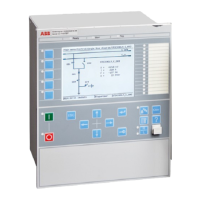In parallel operation with the circulating current method, different
USet
values for individual
transformers can cause the voltage regulation to be unstable. For this reason, the mean value
of
USet
for parallel operating transformers can be automatically calculated and used for the
voltage regulation. This is set
On
/
Off
by setting parameter
OperUsetPar
. The calculated mean
USet
value is shown on the local HMI as a service value USETPAR under Main menu/Test/
Function status/Control/TransformerVoltageControl(ATCC,90)/TR8ATCC:x.
The use of mean
USet
is recommended for parallel operation with the circulating current
method, especially in cases when Load Voltage Adjustment is also used.
Line voltage drop compensation for parallel control
SEMOD159053-186 v3
The line voltage drop compensation for a single transformer is described in section
"Line
voltage drop". The same principle is used for parallel control with the circulating current
method and with the master – follower method, except that the total load current, I
L
, is used in
the calculation instead of the individual transformer current. (See figure 153 for details). The
same values for the parameters
Rline
and
Xline
shall be set in all IEDs in the same parallel
group. There is no automatic change of these parameters due to changes in the substation
topology, thus they should be changed manually if needed.
Avoidance of simultaneous tapping
SEMOD159053-189 v1
Avoidance of simultaneous tapping (operation with the circulating current method)
SEMOD159053-191 v3
For some types of tap changers, especially older designs, an unexpected interruption of the
auxiliary voltage in the middle of a tap manoeuvre, can jam the tap changer. In order not to
expose more than one tap changer at a time, simultaneous tapping of parallel transformers
(regulated with the circulating current method) can be avoided. This is done by setting
parameter
OperSimTap
to
On
. Simultaneous tapping is then avoided at the same time as
tapping actions (in the long term) are distributed evenly amongst the parallel transformers.
The algorithm in Automatic voltage control for tap changer, parallel control TR8ATCC will
select the transformer with the greatest voltage deviation U
di
to tap first. That transformer
will then start timing, and after time delay
t1
the appropriate URAISE or ULOWER command
will be initiated. If now further tapping is required to bring the busbar voltage inside
UDeadbandInner
, the process will be repeated, and the transformer with the then greatest
value of U
di
amongst the remaining transformers in the group will tap after a further time
delay
t2
, and so on. This is made possible as the calculation of I
cc
is cyclically updated with the
most recent measured values. If two transformers have equal magnitude of U
di
then there is a
predetermined order governing which one is going to tap first.
Avoidance of simultaneous tapping (operation with the master follower method)
SEMOD159053-197 v2
A time delay for the follower in relation to the command given from the master can be set
when the setting
MFMode
is
Follow Tap
that is, when the follower follows the tap position
(with or without an offset) of the master. The setting parameter
tAutoMSF
then introduces a
time delay on UVRAISE/ULOWER commands individually for each follower, and effectively this
can be used to avoid simultaneous tapping.
Homing
SEMOD159053-200 v2
Homing (operation with the circulating current method)
SEMOD159053-205 v3
This function can be used with parallel operation of power transformers using the circulating
current method. It makes possible to keep a transformer energized from the HV side, but open
on the LV side (hot stand-by), to follow the voltage regulation of loaded parallel transformers,
and thus be on a proper tap position when the LV circuit breaker closes.
For this function, it is needed to have the LV VTs for each transformer on the cable (tail) side
(not the busbar side) of the CB, and to have the LV CB position hardwired to the IED.
In TR8ATCC block for one transformer, the state "Homing" will be defined as the situation
when the transformer has information that it belongs to a parallel group (for example,
information on T1INCLD=1 or T2INCLD=1 ... and so on), at the same time as the binary input
1MRK 511 358-UEN A Section 13
Control
309
Application manual

